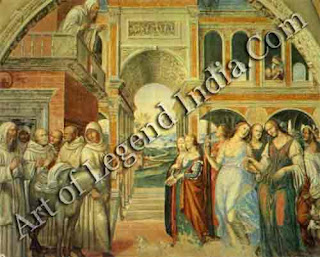 Monastic Life
Monastic Life
By the
15th century the monasteries had become notorious for their worldliness and
debauchery, yet there were some devout orders in which monks led austere lives
of study and prayer.
'They
cheat, steal, fornicate, and when they are at the end of their resources they
set up as saints and work miracles.' Such was the charge made against friars by
the 15th century Italian author Masuccio, and his opinion was shared by many of
his contemporaries.
In the
growing secular and commercial atmosphere of Renaissance Florence, monastic
life appeared parasitic. The most virulent dislike was reserved for the friars
in the mendicant (begging) orders the Franciscans, Dominicans and Carmelites,
all of whom had settled in Florence during the 13th century.
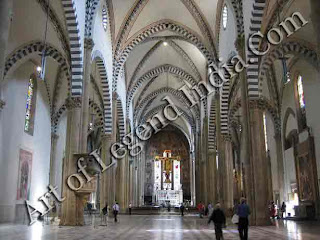 But to
a large extent, it was the hypocritical flouting of the basic monastic rules of
poverty, chastity and obedience which inflamed the public. Contemporary records
make it clear that it was not unusual for friars and priests to carry weapons
and hunt, or to keep mistresses and father children.
But to
a large extent, it was the hypocritical flouting of the basic monastic rules of
poverty, chastity and obedience which inflamed the public. Contemporary records
make it clear that it was not unusual for friars and priests to carry weapons
and hunt, or to keep mistresses and father children.
Obedience
to religious rules seemed equally lax in many convents of nuns. Masuccio went
so far as to claim: Some nuns are formally wedded to monks, with the
accompaniments of mass, a marriage contract and a liberal indulgence in food
and wine. The nuns afterward bring forth pretty little monks or else use means
to hinder that result'.
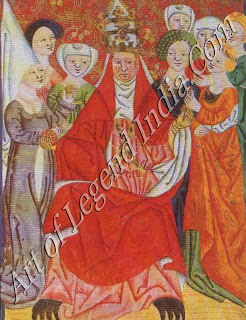 No
doubt exaggerated for satirical effect, Masuccio's claim nevertheless held more
than a grain of truth. Often, monasteries and nunneries were close enough for
members of the orders to mingle and to share beds. Monastery archives testify
to this fact with their volumes given over to the trials of cohabiting monks
and nuns. Immorality was so rife that rumours began to be heard in favour of
priests marrying.
No
doubt exaggerated for satirical effect, Masuccio's claim nevertheless held more
than a grain of truth. Often, monasteries and nunneries were close enough for
members of the orders to mingle and to share beds. Monastery archives testify
to this fact with their volumes given over to the trials of cohabiting monks
and nuns. Immorality was so rife that rumours began to be heard in favour of
priests marrying.
In
addition to this, the religious orders were openly becoming worldlier. They
courted the patronage of princes and businessmen, owned large amounts of land,
sold pardons and deathbed absolutions, and concerned themselves intimately with
the affairs of the people and political life. Some monks also took advantage of
the anonymity and sanctity their habits afforded them and acted as agents and
go-betweens in conspiracies and murder-plots.
POOR CANDIDATES
A
decline in monastic standards was almost inevitable at a time when candidates
were admitted too easily and for the wrong reasons. Many were the children of
impoverished noble families who paid a one-off sum to the monastery to secure a
respectable career for their offspring, and not all had true vocations for the
religious life. The level of learning was generally not high and many
candidates had no aptitude for study. However, there were those who pursued
lives of prayer, study and work, and monks who belonged to the well-endowed
monasteries in the great city states of Pisa, Milan and particularly Florence
were the privileged members of some of the best centres of learning in Europe.
Nowhere
are the extremes of monastic types more apparent than in the lives of the
Florentine painter-monks, Fra Angelico and Fra Filippo Lippi. In 1421 Lippi, an
orphan, was placed in the Carmelite priory in Florence. But his unsuitability
for such a life was shown by his subsequent trial for fraud, and his abduction
of a nun, Lucrezia, whom he later married and who bore him a son, Filippino,
who also became a painter.
In
marked contrast, Fra Angelico led a reverent life within the Dominican order,
earning for himself the title of Beato, meaning 'blessed one'. Although the
qualities of spirituality and grace that are found in his paintings may have
enhanced his reputation, his life in the Florentine monastery of San Marco was
certainly a devout one.
THE DOMINICANS
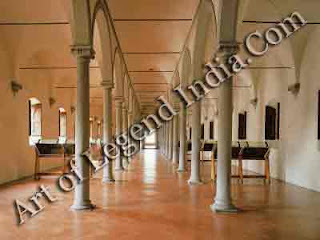 From
the early 13th century, the Dominican order had been based in the western part
of Florence, around the church of Sta Maria Novella. The Dominicans stressed
religious orthodoxy and obedience to the pope. They had a strong commitment to
learning as well as to preaching, I and set up studia generale, a form of
higher education catering not only for members of their shown order but for
secular students too. Similar establishments were founded by the Franciscans
and Augustinians in other parts of the city. The teachers came from within the
order, but were sent to study abroad at universities such as Paris and Bologna.
Dante, a pupil of the studio, is proof of the high standards of learning that
the system fostered.
From
the early 13th century, the Dominican order had been based in the western part
of Florence, around the church of Sta Maria Novella. The Dominicans stressed
religious orthodoxy and obedience to the pope. They had a strong commitment to
learning as well as to preaching, I and set up studia generale, a form of
higher education catering not only for members of their shown order but for
secular students too. Similar establishments were founded by the Franciscans
and Augustinians in other parts of the city. The teachers came from within the
order, but were sent to study abroad at universities such as Paris and Bologna.
Dante, a pupil of the studio, is proof of the high standards of learning that
the system fostered.
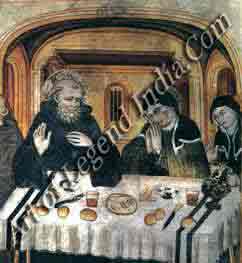
The
history of the Dominican monastery of San Marco demonstrates the close links
between political and business interests and religious life. Although
professing humanist ideas, Cosimo de' Medici the ruler of Florence was anxious
to keep his Christian life blameless. Apparently suffering from prickings of
conscience that 'certain portions of his wealth had not been righteously
gained', Cosimo was advised by the pope to use the money to extend the
monastery around the church of San Marco, which he had recently handed over to
the Observantist Dominicans, a reforming branch of the order. In this way,
Cosimo could 'unburden his soul'.
Work
began on the new monastery and library of San Marco in 1437. The plan followed
traditional monastic lines, with the rooms built around three sides of a
cloister, with the guest hospice, the chapter house and the refectory
downstairs, and the monks' study-cells, dormitories and the library on the
first floor. But the light, classical simplicity of the architecture set the
monastery apart from others in the city, and the library became a pattern for
subsequent Italian monasteries. When in 1444 Cosimo donated a collection of
over 400 Greek and Latin manuscripts to the library, San Marco became the
largest and most influential of the early public libraries in Italy.
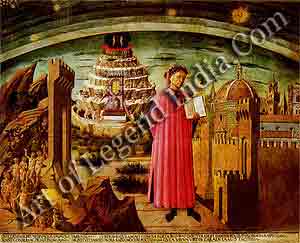
The
second prior of San Marco was Antoninus Pierozzi, who took up his post in 1439
and later authorized the decoration of the monastery's cell walls with the
wonderful frescoes of Fra Angelico. He later became Archbishop of Florence and
was made a saint at his death. His life was led according to the austerest
Dominican precepts; he gave a third of his income to charity and, as was the
monastic rule, provided food and sustenance to the Florentine poor and the
swarms of beggars who visited the monastery with their children. He also
founded an organization for the poveri vergognosi, the 'embarassed poor', who
were too ashamed to let their poverty be known publicly.
Antonino's
moral guidance also led to a drive to reform both the Florentine clergy and
monastic discipline within his own monastery. Here the principles laid down for
all Dominican friars were strictly observed, with the celebration of the six
liturgical offices, each lasting for three hours, forming the basis of the
monastic day.
In most
orders there was little privacy, with monks sleeping in large dormitories.
Because of the Dominican emphasis on learning, individual cells had developed,
where members could obtain a degree of privacy and silence for studying. These
were generally small rooms arranged on each side of a central corridor, from
which the interior of each cell was visible.
MEALS AND RECREATION
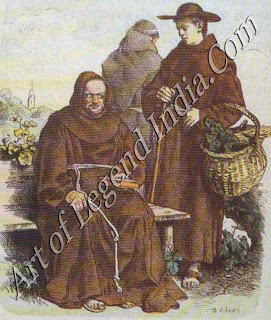 Meals
were frugal, although the Florentine orders were well provided by their
farmlands in Tuscany, which supplied them with wine, wheat, beer and oil. Two
meals a day were eaten in summer (from Easter to mid-September) and generally
only one in winter. Extra food was allowed on feast days but no meat was served
in the monastery. Wine or beer was commonly served at meals, although it was
frequently withdrawn as a penance. Silence was observed at meals and for most
of the day.
Meals
were frugal, although the Florentine orders were well provided by their
farmlands in Tuscany, which supplied them with wine, wheat, beer and oil. Two
meals a day were eaten in summer (from Easter to mid-September) and generally
only one in winter. Extra food was allowed on feast days but no meat was served
in the monastery. Wine or beer was commonly served at meals, although it was
frequently withdrawn as a penance. Silence was observed at meals and for most
of the day.
After
the midday meal came a brief period of recreation, when friars could talk or
exercise on the gardens. Relaxation did not include running, playing games,
laughing loudly or singing especially singing vulgar songs although by the
Renaissance, many warnings for this kind of behaviour are recorded.
DECLINING STANDARDS
After
the death of Antonino, the standards at San Marco declined until later in the
century, when the puritannical zeal of a yet more famous prior, the martyr
Savonarola, brought a new wave of reforms, not only within the walls of the
monastery but throughout the whole of Florence.
Writer – Marshall
Cavendish
 Monastic Life
Monastic Life But to
a large extent, it was the hypocritical flouting of the basic monastic rules of
poverty, chastity and obedience which inflamed the public. Contemporary records
make it clear that it was not unusual for friars and priests to carry weapons
and hunt, or to keep mistresses and father children.
But to
a large extent, it was the hypocritical flouting of the basic monastic rules of
poverty, chastity and obedience which inflamed the public. Contemporary records
make it clear that it was not unusual for friars and priests to carry weapons
and hunt, or to keep mistresses and father children.  No
doubt exaggerated for satirical effect, Masuccio's claim nevertheless held more
than a grain of truth. Often, monasteries and nunneries were close enough for
members of the orders to mingle and to share beds. Monastery archives testify
to this fact with their volumes given over to the trials of cohabiting monks
and nuns. Immorality was so rife that rumours began to be heard in favour of
priests marrying.
No
doubt exaggerated for satirical effect, Masuccio's claim nevertheless held more
than a grain of truth. Often, monasteries and nunneries were close enough for
members of the orders to mingle and to share beds. Monastery archives testify
to this fact with their volumes given over to the trials of cohabiting monks
and nuns. Immorality was so rife that rumours began to be heard in favour of
priests marrying.  From
the early 13th century, the Dominican order had been based in the western part
of Florence, around the church of Sta Maria Novella. The Dominicans stressed
religious orthodoxy and obedience to the pope. They had a strong commitment to
learning as well as to preaching, I and set up studia generale, a form of
higher education catering not only for members of their shown order but for
secular students too. Similar establishments were founded by the Franciscans
and Augustinians in other parts of the city. The teachers came from within the
order, but were sent to study abroad at universities such as Paris and Bologna.
Dante, a pupil of the studio, is proof of the high standards of learning that
the system fostered.
From
the early 13th century, the Dominican order had been based in the western part
of Florence, around the church of Sta Maria Novella. The Dominicans stressed
religious orthodoxy and obedience to the pope. They had a strong commitment to
learning as well as to preaching, I and set up studia generale, a form of
higher education catering not only for members of their shown order but for
secular students too. Similar establishments were founded by the Franciscans
and Augustinians in other parts of the city. The teachers came from within the
order, but were sent to study abroad at universities such as Paris and Bologna.
Dante, a pupil of the studio, is proof of the high standards of learning that
the system fostered.  Meals
were frugal, although the Florentine orders were well provided by their
farmlands in Tuscany, which supplied them with wine, wheat, beer and oil. Two
meals a day were eaten in summer (from Easter to mid-September) and generally
only one in winter. Extra food was allowed on feast days but no meat was served
in the monastery. Wine or beer was commonly served at meals, although it was
frequently withdrawn as a penance. Silence was observed at meals and for most
of the day.
Meals
were frugal, although the Florentine orders were well provided by their
farmlands in Tuscany, which supplied them with wine, wheat, beer and oil. Two
meals a day were eaten in summer (from Easter to mid-September) and generally
only one in winter. Extra food was allowed on feast days but no meat was served
in the monastery. Wine or beer was commonly served at meals, although it was
frequently withdrawn as a penance. Silence was observed at meals and for most
of the day. 
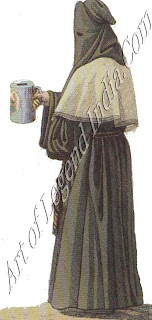












0 Response to "Italian Great Artist Fra Angelico - Monastic Life"
Post a Comment